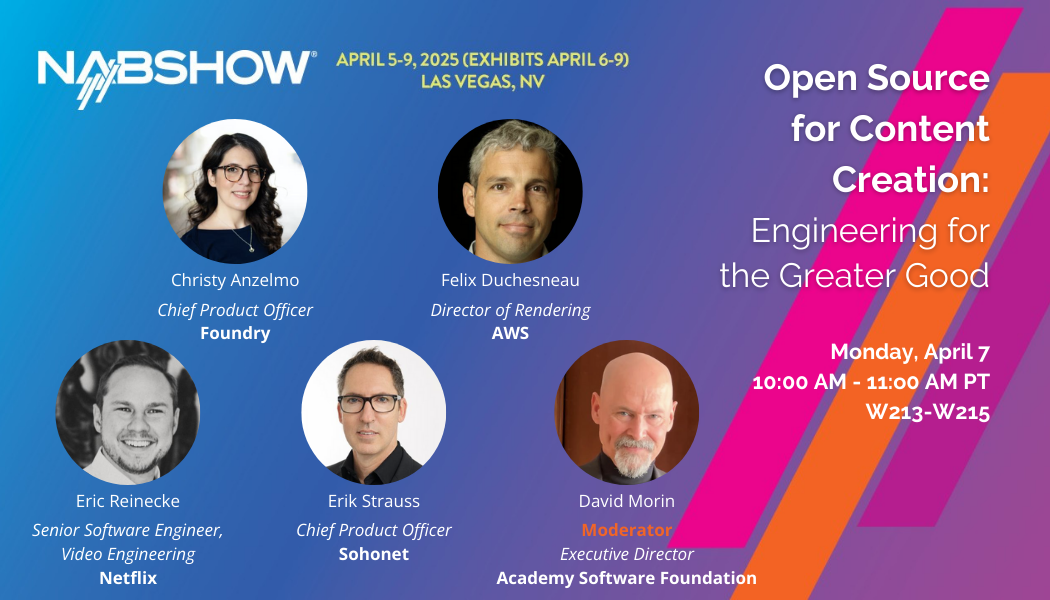Guest post by Michael Dolan, OpenColorIO TSC Chair, and Doug Walker, OpenColorIO TSC Chief Architect
It’s been just over a year since OpenColorIO (OCIO) was accepted into the Academy Software Foundation, so it’s a good time to take a moment to provide an update on the state of the project. This blog post will give you a snapshot of recent activity and an overview of what’s coming up.
Development
Six months ago, OpenColorIO graduated from the Incubation stage to become an officially Adopted ASWF project. All projects entering the Foundation start in the Incubation stage. In order to achieve Adopted status, we had to demonstrate a healthy number of committers from a diverse contributor base and an ongoing flow of commits and merged contributions, achieve a Core Infrastructure Initiative Best Practices Badge, and complete an initial license scan of the project codebase, among other requirements.
Development has been very active — in 2019 there were 204 pull-requests merged into the main repo on GitHub from 19 contributors. In addition, Thomas Mansencal (Weta Digital) has been keeping OpenColorIO in sync with ACES and has developed configs for the ACES 1.1 and 1.2 releases.
OpenColorIO v2
Our major initiative is the development of OCIO v2, being led by Autodesk, which has three full-time engineers working on it. This work has been in progress since the proposed feature set was validated with the community at SIGGRAPH 2017. It’s going to be a very big release. Pull requests are made into the master branch on GitHub on a weekly basis. Working group meetings to validate and discuss the design and implementation are held monthly on Zoom, open to all.
The OCIO v2 plan is still tracking to the roadmap presented at SIGGRAPH 2019. The goal is to reach feature-complete status by SIGGRAPH of this year. The second half of the year will be a stabilization and bug-fixing period as product developers start to integrate the new version into their applications. We hope to see v2 arrive in products next year in anticipation of it being included in the VFX Reference Platform CY2021.
New Feature Highlights
Presentations at the past two SIGGRAPH BoFs demonstrated improvements to the GPU renderer (it now has parity with the CPU), major optimization of the CPU renderer (now up to 31x faster and supports integer pixel formats), and features to improve native ACES support. More recently we’ve implemented complete support for the new version of the Academy/ASC Common LUT Format (CLF) that is part of ACES 1.2. The CLF format is well suited to the OCIO architecture and the latest version allows use of OCIO’s enhanced Log and Exponent operators, among other features.
A number of the new features relate to the config files. The new FileRules feature provides a more flexible way of determining the color space from a filename with glob and regex pattern matching. Another feature allows color spaces to be flagged as inactive, which prevents them from appearing in menus, while remaining accessible to applications internally. Also, it’s now possible to convert from a color space in one config to a color space in another config, as long as both configs implement a specific interchange role or a common color space definition. Of course, all of the new config features in v2 are optional, and the v1 config files are still fully supported.
One of the new architectural features is the option to use a display-referred reference space in addition to the (typically) scene-referred reference space. This better aligns OCIO with important color standards such as SMPTE ST-2065 (ACES), ITU-R BT.2100 (HDR TV), and ISO 22028-1 (image states). It also makes it simpler to convert between video color spaces.
Another feature currently in progress is the ability to reference built-in transforms in configs (e.g. the ACEScc or ST-2084 curves). These optional transforms will make it easier to develop config files and reduce the need for external LUTs by providing built-in access to a set of commonly used transforms (e.g. most of the transforms in the ACES config). They’re like the existing FileTranform but without the files. 😉
Outreach
Just over a year ago, we started fresh email lists at lists.aswf.io and now have 205 subscribers to ocio-user, 138 for ocio-dev, and over 100 users on Slack.
Over the last two months, Michael Dolan (Epic Games) and Doug Walker (Autodesk) made a presentation on OCIO at the ASWF Open Source Forum, Mario Rokicki (DNEG) and Matthias Scharfenberg (ILM) presented at Spark FX in Vancouver, and Doug Walker presented at the Hollywood Post Alliance (HPA) Tech Retreat.
In addition, ASWF has been accepted as a mentoring organization for Google Summer of Code, and we’ve been excited to see some new faces taking an interest in the project. Our Technical Steering Committee (TSC) continues to hold weekly meetings on Zoom, open to all.
Conclusion
Looking back over our first year in the ASWF, we feel the project has come a long way, not only in terms of development but also in the expansion of the community and in the adoption of the robust ASWF governance model and infrastructure. This summer should be an exciting time with the roll out of the v2 release, and we look forward to sharing it with you and maybe even bumping elbows at SIGGRAPH!
Michael Dolan is a Senior Pipeline Developer at Epic Games. He is the Chair of the OpenColorIO Technical Steering Committee (TSC) and a member of the ASWF Technical Advisory Council (TAC).
Doug Walker is the Technology Lead for Color Science at Autodesk and is serving as the OpenColorIO TSC Chief Architect. He is also the chair of the ACES Common LUT Format implementation working group and a member of the ACES Architecture TAC.



